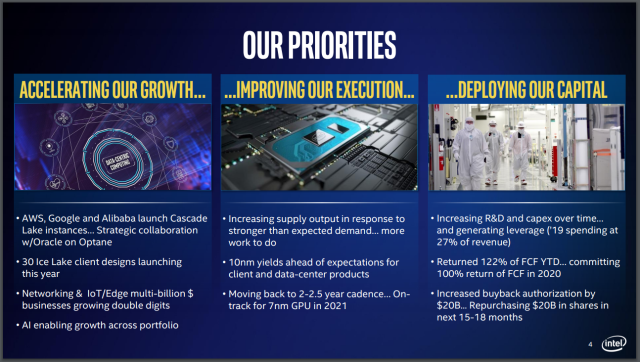Intel's years-long struggle with the 10nm manufacturing process may finally be over. The company told investors last week that its 10nm yields are ahead of expectations for both client and data center products—and it's bringing a new 10nm production facility online, as well. Currently, all 10nm parts are produced in two of the company's plants: Hillsboro, Oregon, and Kiryat Gat, Israel. But beginning next quarter, Intel's fabrication facility in Chandler, Arizona, will also be producing 10nm parts.

What we find more interesting than the 10nm recovery is that Intel still seems to be very serious about pivoting away from being a CPU company. Since 1991, the iconic "Intel Inside" logo has referred to the CPU in your computer, but the company sees more potential in investments in storage, software, networking, AI, and the data center.
This certainly doesn't mean Intel plans to exit the consumer and server CPU business, but it does herald a large shift in the company's overall focus. The company estimates the TAM—Total Addressable Market, or the maximum revenue if literally every potential customer bought an Intel product—of its traditional PC and server CPU line at $52 billion. However, it sees an additional $220 billion TAM potential in what it calls "Data-centric" products in data center, Internet of Things, and networking market segments.
Intel wants to shift much of its focus away from the CPU and onto what it's dubbing the "XPU"—a term it's pushing which includes GPUs, FPGAs, and other more specialized processors. Intel Corporation Intel's game plan, interestingly, explicitly includes shifting away from a protectionist and defensive focus on CPUs to grow in other areas instead. Intel Corporation Intel sees a much larger and more profitable market available in what it calls "data-centric" products than its current traditional PC and server market. The company intends to shift its primary focus in that direction. Intel Corporation
This means the company intends to continue making its heaviest bets in areas such as Optane storage, hardware Artificial Intelligence acceleration, 5G modems, data center networking, and more. The slide that really drives this commitment home comes from Q2's investor meeting that explicitly shows the company moving from a "protect and defend" strategy to a growth strategy. If this slide were in a sales meeting, it wouldn't say much—but delivered to the company's investors, it gains a bit of gravitas.
Most of this was revealed nearly six months ago at the company's May 2019 investor's meeting, but the Q3 investor's meeting last week continues with and strengthens this story for Intel's future growth, with slides more focused on Optane, network, and IoT/Edge market growth than with the traditional PC and server market.
The company shows its new "data-centric" market as having already caught up with its traditional PC-centric market, with almost 50% of its Q3 revenue derived from data-centric products. The majority of the operating income (roughly speaking, profit) returns from those products is outpacing the traditional market as well.







